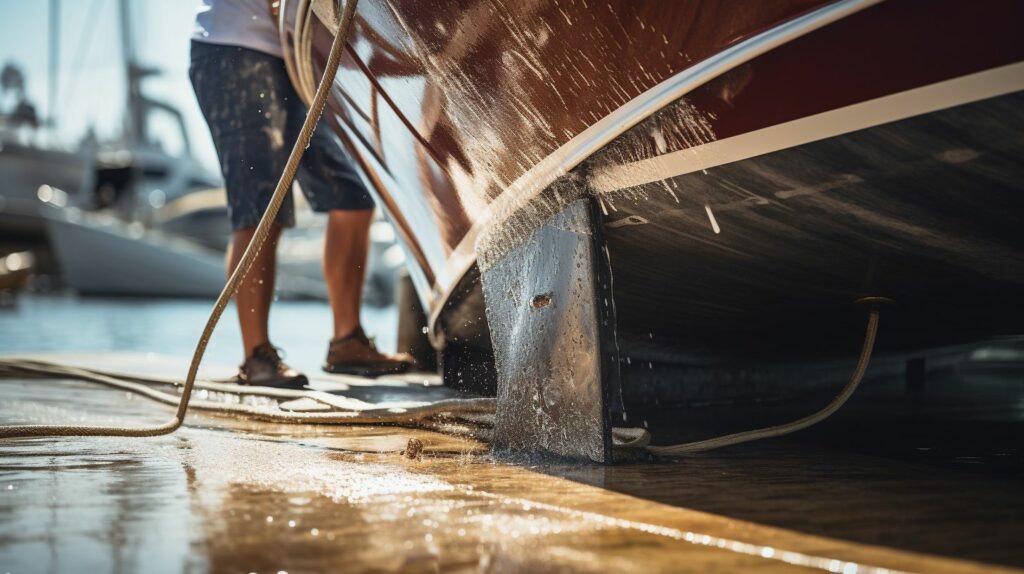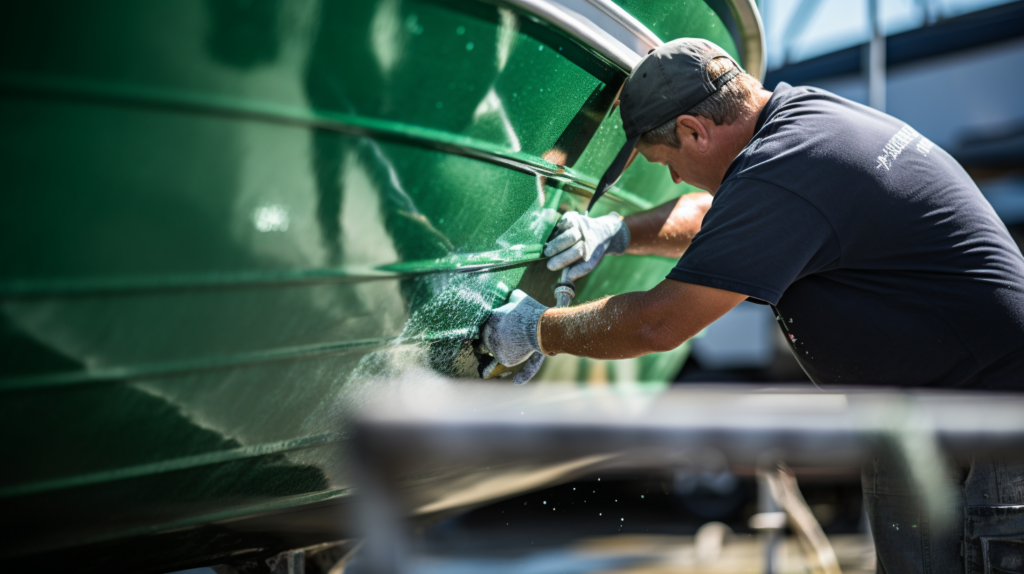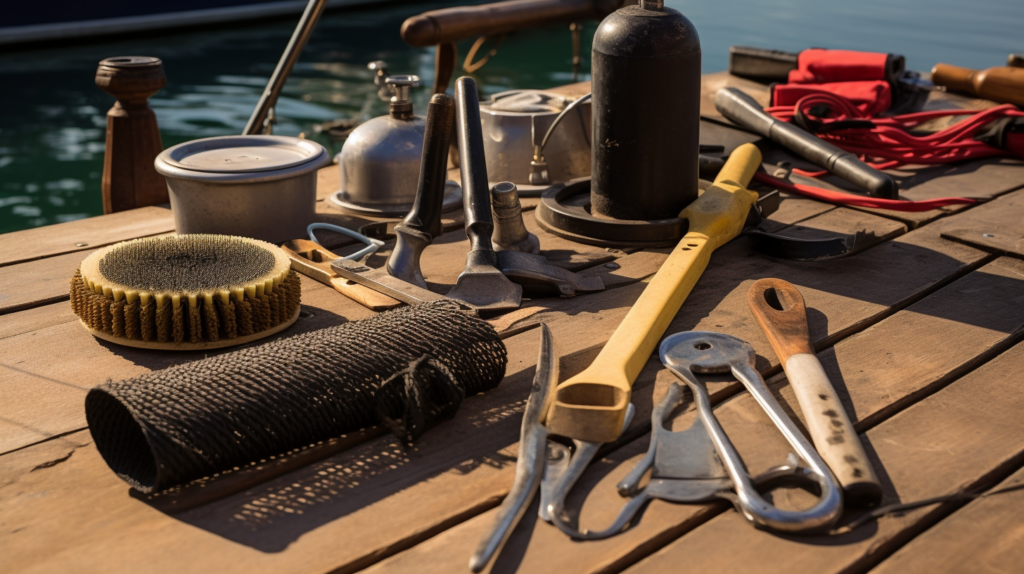Table of Contents
Table of Contents

Over time, grime, algae, rust, and even barnacles can accumulate on the hull of your boat. These outdoor elements not only decrease your boat’s overall appearance but can also impact its performance in the water.
In this guide, we’ll walk you through a five-step approach to effectively clean your boat hull using safe and efficient tools and products. Get ready to restore that fresh-off-the-lot shine!
Key Takeaways
- Boat hull cleaning is important for both looks and performance. A clean hull helps your boat run more efficiently.
- Use special tools, like an extended rotary brush and a boat hull scraper, to reach all spots on the hull. This makes cleaning easier and safer for you.
- Safe products are key to successful cleaning. Products with oxalic acid, phosphoric acid, or mild citric acid work well and don’t harm marine life.
- The best way to keep your boat looking new is regular maintenance. Cleaning often can stop barnacles or rust from causing serious damage!
Understanding the Importance of Hull Cleaning

Boat owners should give high priority to hull cleaning. Maintaining a clean hull not only preserves the boat’s aesthetic appeal but also contributes significantly to its overall performance and longevity.
Regular hull cleaning thwarts the accumulation of salt deposits in saltwater and tannin stains from freshwater, enabling an enduring pristine finish on your boat.
A dirty or unkempt hull can lead to multiple problems such as decreased fuel efficiency due to increased drag, corrosion, or even severe damage requiring costly repairs. On another note, using specific products designed for boat bottom cleaning will yield superior results without risking injury that might arise from employing personal-use substances like muriatic acid.
The potential harm posed by DIY methods outweighs the benefits gained from professional care or suitable commercial products.
Proper cleaning of barnacles and treating rust stains present other vital components of comprehensive hull maintenance. Tools like a good quality scraper complemented with effective solutions such as rust remover or a cleaner specifically tailored for fiberglass boat hulls vastly improve protection against these common maritime hindrances.
Remember that neglecting regular upkeep may impact more than just appearance; it could compromise your vessel’s performance, durability, and even safety over time – underscoring why understanding how to clean is pivotal for every conscientious sailor out there-.
Steps to Cleaning the Hull of a Boat

First, we need to tackle waterline stains – these unsightly marks can be removed using an efficient hull cleaner product that’s tough on tannins and algae. To clean salt stains from the hull, a mix of fresh water and vinegar works well for scrubbing off the accumulated residue.
Rust stains should never linger long on your boat as they could lead to severe corrosion; rust removers expediently get rid of such blemishes. Lastly, barnacles and their husks must be scraped off promptly with a hull scraper designed for this very purpose.
With each step, ensure you’re practicing effective cleaning techniques specific to your boat type (fiberglass or metal) to preserve its properties and longevity.
Removing Waterline Stains
Waterline stains on a boat’s hull often result from exposure to freshwater or saltwater and are frequently accompanied by the accumulation of dirt, algae, or tannins. Boat owners can employ an assortment of effective methods to tackle these stubborn marks.
Using certain cleaning chemicals like muriatic acid or oxalic acid proves beneficial in such cases since they have a strong reaction against stains.
Applying these cleaners directly at the waterline with a sponge aids in breaking down the stain molecules for easy removal. Always make sure to wear protective clothing during this process as some acids can be corrosive.
After applying and scrubbing, thoroughly rinse the hull with fresh water to avoid any residue build-up that could damage your boat’s finish over time.
Cleaning Salt Stains
Salt stains on the hull can trap dirt and give your boat an unsightly appearance over time. These stains often build up at and below the waterline, especially in saltwater environments.
It’s important to keep these areas well maintained by regularly washing and waxing your boat hull using appropriate cleaning chemicals. For tough salt deposits, consider applying certain products like salt removers that can be easily sprayed on and then rinsed off without harming your fiberglass boat hull or graphics.
Do ensure to thoroughly scrub the stained area with a sponge during the washing phase for effective results. After removing those stubborn salt stains, your clean water rinse should result in a gleaming hull ready to conquer any boating challenges on the water!
Eliminating Rust Stains
Spotting rust stains on your boat’s hull might seem alarming. However, a careful approach can help you tackle these nuisances without any fuss. First, identify the source of the rust to prevent future stains; look for corroded metal fixtures as common culprits and replace them if necessary.
Use a safe but effective rust remover available from most marine supply shops or consider natural options like lemon juice mixed with salt applied with a soft brush. Allow it to soak for 15 minutes before washing off thoroughly with fresh water.
For tougher spots, a specialized hull cleaner provides an extra punch without damaging the gel coat of your vessel. Avoid using muriatic acid as it can cause lasting damage if not handled by professionals.
Handling Barnacles and Barnacle Husks
Barnacles and barnacle husks pose a special challenge in boat hull cleaning. These unwanted hitchhikers latch onto the surface of your boat’s hull and impede its efficiency. To get rid of them, use wooden or plastic scrapers to avoid damaging the fiberglass finish.
Direct scraping should suffice for smaller patches, but larger infestations might require specialized tools like motorized underwater rotary brushes or professional hull cleaning divers’ assistance.
Persistent care is paramount; barnacles grow fast, so monthly cleanings often become necessary especially if you want to maintain a clean boat bottom. Consider too that these tough marine critters can harm local wildlife when improperly handled—always opt for environmentally safe methods when dealing with them during your regular in-water hull cleaning sessions.
Tools Required for Efficient Hull Cleaning

To clean your boat’s hull efficiently, you will require specific tools such as an extended rotary brush for reaching hard-to-reach spots, a boat hull scraper to remove stubborn stains and barnacles, Hull bottom cleaning pads for thorough scrubbing, and a motorized underwater rotary brush system for in-water cleaning.
Extended Rotary Brush
The Extended Rotary Brush emerges as a crucial tool for effective boat hull cleaning. It enjoys particular design features tailored to serve the specific needs of bottom-of-the-boat cleaning, even while the boat remains in the water.
Scrubbing your boat’s hull using this brush not only enhances its aesthetic appeal but also helps prevent motor overheating issues. The process binds two benefits together – prolongs the hull’s life and boosts both the speed and fuel efficiency of your marine pride.
For optimal performance, pair it with other tools like a motorized underwater rotary brush system, a hull scraper, or bottom-cleaning pads. You can expect to spend roughly 40 minutes on an average-sized leisure boat when using this tool for in-water hull cleaning; time well spent to ensure your vessel maintains top-notch condition and performance.
Boat Hull Scraper
A boat hull scraper is an essential tool needed for thorough cleaning. It plays a significant role in the removal of stubborn barnacles attached to your boat’s hull. Due to their hard and rough nature, barnacles need specialized tools for proper extraction without causing harm to the fiberglass surface of your hull.
This is where a boat hull scraper comes into play, acting as an effective implement that uproots these obstructions with minimal risk to your vessel’s exterior finish. Beyond this, it can also assist in applying antifouling paint, adding another layer of protection against future marine growths on the bottom of your boat.
A wooden or plastic scraper is most recommended because they are less likely to scratch or gouge the material underneath compared to metal ones.
Hull Bottom Cleaning Pads
Hull bottom cleaning pads are an essential tool for maintaining your boat’s hull. They are typically made of abrasive material secured to a hand-sized pad, which makes scrubbing off stubborn barnacles and rust easier.
Hull cleaning pads come in various strengths – from gentle to heavy-duty, depending upon the type of stain or buildup on your boat’s hull. While using these pads, apply even pressure across the surface to avoid scratching or damaging the finish.
Additionally, when dealing with tough stains like tannins or algae, use these pads in combination with specialized boat hull cleaners for best results. Regular use of these tools can increase your boat’s endurance and maintain its sleek appearance on the water.
Motorized Underwater Rotary Brush System
A motorized underwater rotary brush system is not just cool to talk about; it’s an essential tool for every boat owner seeking efficient hull cleaning. With its powerful, rotating bristles, it clears away stubborn stains and hard marine growth like barnacles from your boat bottom.
It operates right in the water, which makes cleaning a smooth process without the need to haul out your vessel.
The real appeal of this device lies in its convenience and effectiveness. Unlike manual scrubbing methods, this electric-powered setup reduces effort while offering thorough cleanups.
The high-speed brushing action reaches even difficult spots on the hull surface with ease. Having this equipment at hand saves time and keeps the hull of your boat looking as good as new after each cleanup session.
Precautions when Cleaning a Boat Hull in Water

Always prioritize safety while performing in-water hull cleaning. Make sure to wear a wetsuit and buoyancy aid, as these not only protect you from the cold but also enhance your floating abilities.
Gloves are essential too, they safeguard your hands, especially during the removal of barnacles with a scraper.
Avoid using harsh chemicals that can harm local wildlife or disrupt marine life around marinas. Products containing muriatic acid do a great job of eliminating stains; however, they should only be used by professional hull cleaners due to their corrosive nature which can bring about irreversible damage.
Opt for boat hull cleaners with oxalic acid, phosphoric acid, or mild citric acid which are safer and equally effective.
When dealing with stubborn barnacles and rust marks on metal fixtures, take care not to use abrasive materials that may scratch or otherwise damage the finish of fiberglass boat hulls.
Instead of metal implements, consider employing wooden or plastic tools for scraping off such buildup safely.
Lastly, ensure there is ample ventilation if you’re cleaning your boat dockside – fumes from certain cleaning products may pose health risks when inhaled over extended periods. Always follow product usage instructions diligently for optimal results and safety considerations.
How Often Should a Boat Hull Be Cleaned?
The frequency of boat hull cleaning depends on several factors. These include:
– The type of water your boat is used in Fresh, brackish, or saltwater.
– Where the vessel is stored when not in use: At a marina, on a trailer, or a dry dock.
– The materials your boat’s hull is made from Fiberglass, aluminum, wood, or steel.
Generally for boats that spend their time in salt water and are moored in the water year-round, monthly cleanings can help prevent buildup. For freshwater vessels and those stored out of water when not in use; biannual cleanings could be adequate.
Always keep an eye out for visible signs of fouling such as algae growth or barnacle attachment.
Boat owners should also consider environmental regulations regarding hull-cleaning processes adopted by local wildlife agencies and marinas they frequent. Some areas may have restrictions on abrasive techniques while others limit certain cleaning chemicals due to potential harm to marine ecosystems.
Remember that regular maintenance contributes significantly to aesthetic appeal and performance efficiency – less drag leads to better fuel economy!
Ultimately it’s up to individual assessment! Monitor your vessel closely over time so you can determine what works best given its unique conditions and usage patterns.
Conclusion
Keeping your boat’s hull clean is essential for its longevity and performance. The cleaning process can be straightforward with the right tools, techniques, and products. From addressing stubborn barnacles to tackling rust stains, you have control over maintaining your boat’s appearance.
Remember, a clean hull equals a happy boat!
Related Articels
https://www.sailorista.com/what-are-the-parts-of-a-sailboat/
FAQs
1. How do I clean the hull of a boat?
There are several ways to clean the hull of a boat. You can use a boat hull cleaner, scrub the hull with a brush, or consider hiring a professional boat hull cleaning service.
2. What is the importance of cleaning a boat hull?
Cleaning the hull of your boat is essential for maintaining its endurance, and appearance and protecting against damage from rust, barnacles, and algae.
3. What are the boat hull cleaning options?
The options for cleaning a boat hull are vast. You can choose to manually scrub the hull, use a boat hull cleaner, or even consider using muriatic acid for tougher stains.
4. Can I follow simple steps to clean my own boat’s hull at home?
Yes! Boat owners can scrub their boat’s bottom with a sponge or scraper using recommended cleaning products like hull cleaner, or even home remedies like vinegar.
5. Are there specific cleaners for fiberglass boats?
Absolutely! Certain products such as SeaSafe Boat Hull Cleaner are designed especially to clean fiberglass boat hulls without causing any harm.
6. How do I remove stubborn stains on the bottom of my boat?
For tougher water stains or marine growth along the hull, you might need stronger solutions like muriatic acid or oxalic acid but remember to use them carefully!
7. What if I can’t fully reach the underwater areas of my Hull?
Underwater parts may require in-water hull cleaning methods which could involve hiring a professional diver from a reliable cleaning company specialized in handling the bottoms of boats.
8. Is it necessary to clean fresh water-based boats as thoroughly as sea-based boats?
Regardless if your vessel is used in salt life or just freshwater bodies; regular thorough washing sessions including rinsing and proper drying phase will protect your craft against scum debris while ensuring a lasting finish.
9. Is there a specific boat hull cleaner I should use?
Yes, there are several boat hull cleaners available in the market. Look for a cleaner that is specifically designed for boat hulls and is safe to use on the material your boat is made of.
10. Can I use a scraper to scrub the bottom of my boat?
Yes, you can use a scraper to remove stubborn dirt and fouling from the bottom of your boat. However, be careful to use a scraper carefully to avoid damaging the hull.
11. How often should I clean the hull of my boat?
The frequency of hull cleaning depends on various factors such as water conditions, fouling, and usage. It is generally recommended to clean the hull at least once every season or more frequently if needed.
12. What are some hull cleaning products I can use?
There are numerous boat cleaning products available in the market. Some popular ones include environmentally-friendly hull cleaners, acid-based cleaners, and lime and rust removers.
13. Can I use muriatic acid for the bottom cleaning of my boat?
Yes, muriatic acid can be used to clean the bottom of the boat. However, it should be used with caution as it is a strong acid and can damage the hull if not used correctly. It is advisable to follow the manufacturer’s instructions and take appropriate safety measures.
14. How do I clean the entire hull of my boat in one go?
To thoroughly clean the entire hull of your boat, you can start by removing loose dirt and debris. Then, apply a boat hull cleaner or a solution of warm water and mild detergent. Scrub the hull using a brush or sponge, and rinse thoroughly with clean water afterward.

